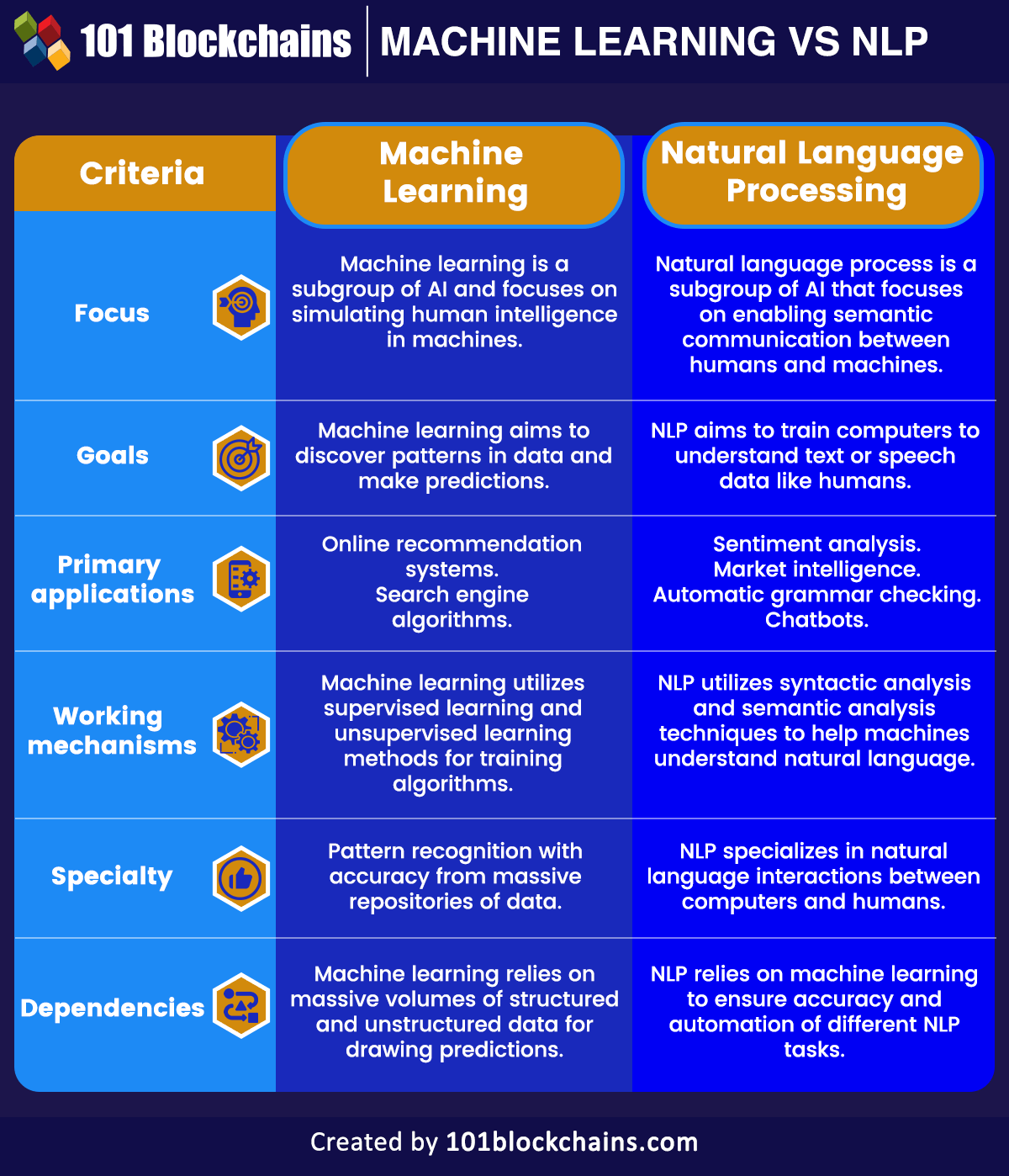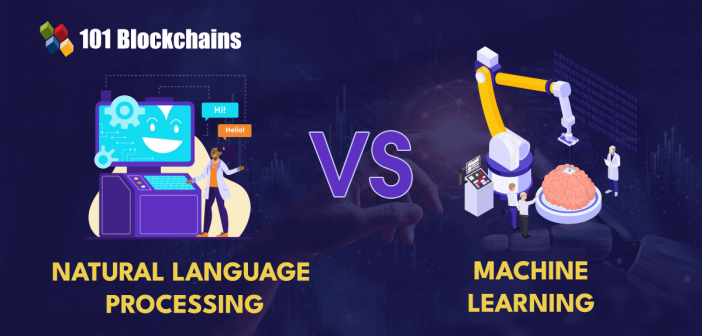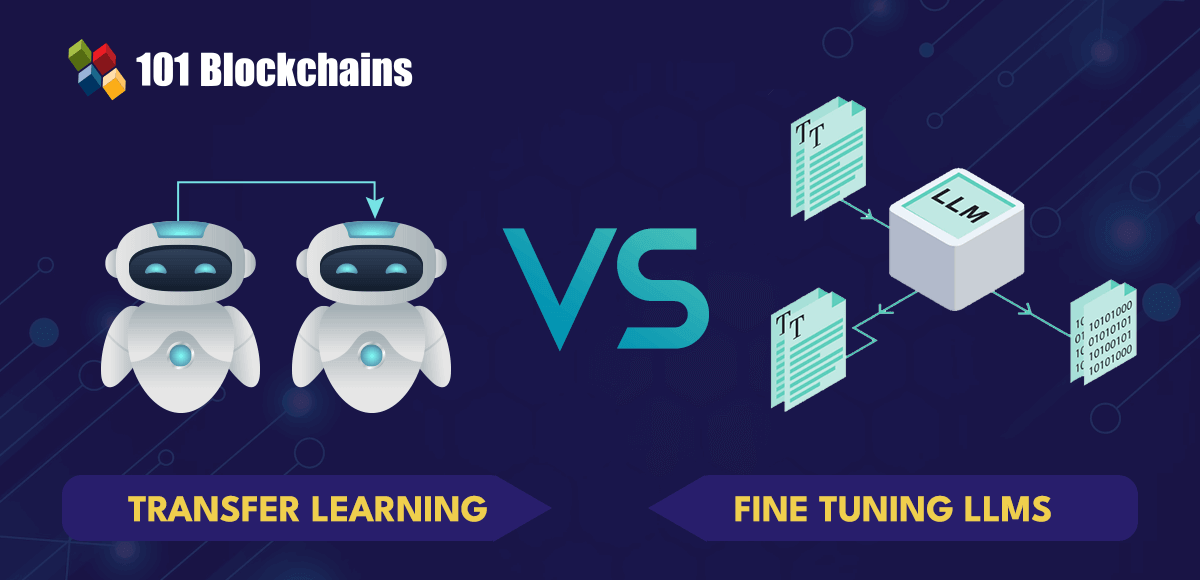The rise of artificial intelligence is not a new trend. AI has been around for longer than you think. However, AI has gained formidable popularity in recent times owing to the rise of tools like ChatGPT and Google Bard. In addition, AI has also emerged as a powerful tool for automation of legacy systems and processes for businesses. The growth of AI has created confusion between different terms, such as natural language processing and machine learning, as well as deep learning. As a matter of fact, people assume that machine learning, NLP, deep learning, and AI are the same terms. However, the trending discussions focus primarily on the natural language processing vs machine learning debate. First of all, you must understand that NLP and ML are two distinct sub-domains or branches of artificial intelligence. Let us explore the natural language processing vs machine learning comparisons.
What Do You Need to Know for Comparing NLP with Machine Learning?
Artificial intelligence is a wider term that encompasses any type of technology that could simulate human intelligence in machines. It aims to empower machines to think, learn, and solve problems in the same approaches as humans. The applications of AI range from search engines such as Google to self-driving cars by Tesla and recommendation systems on YouTube and Netflix.
It is important to understand that ML and NLP are the two crucial sub-domains of AI that help in developing AI solutions. However, NLP and ML are used interchangeably with AI in many cases. You should learn about the definition of natural language processing and ML in detail before comparing them. In addition, it is important to check whether NLP and machine learning depend on each other.
Excited to learn the fundamentals of AI applications in business? Enroll now in the AI For Business Course
Explanation of Machine Learning
The natural language processing vs machine learning debate is incomplete without reflecting on the definition of machine learning. Machine learning is a popular data analysis technique that could help in automation of the process for developing analytical models. It has gained formidable popularity in recent times with its adoption by big names in the world of business and tech.
For instance, machine learning powers the Netflix recommendation system, which has gained a promising reputation for providing accurate and relevant results. The advantage of utilizing machine learning for effective analysis of all customer interactions and touchpoints could help in achieving better personalization. Machine learning provides a nuanced understanding of the factors that drive the decisions and behavior of customers.
The effectiveness of data analysis for forecasting consumer behavior helps in simplifying the NLP vs machine learning debate. Machine learning could provide valuable insights to businesses about the specific content preferred by customers. Machine learning utilizes statistical techniques for solving large volumes of data without the need for human intervention.
Most important of all, machine learning helps machines solve problems like humans, albeit with the utilization of automated processes and large-scale data. In addition, machine learning also includes algorithms that can help ensure efficient completion of tasks in robotics, computer vision, and natural language processing.
Want to understand the importance of ethics in AI, ethical frameworks, principles, and challenges? Enroll now in Ethics Of Artificial Intelligence (AI) Course
Explanation for Natural Language Processing
The second player in the difference between NLP and machine learning, i.e., natural language processing, is another sub-domain of AI. NLP empowers machines to understand and interpret natural language. Machines could rely on natural language processing to understand text or voice data through different tasks.
Some of the most popular NLP tasks include automatic text summarization, speech recognition, and sentiment analysis. You can take a look at Alexa to identify the functionality of NLP. Alexa uses natural language processing to understand the service requests of users. In addition, Alexa also utilizes NLP to prepare a response that humans can understand.
Let us reflect on the importance of NLP with the example of an e-commerce company that allows customers to shop online. The virtual storefront also includes features for meeting with friends and shopping together. Natural language processing could help in transforming the interactions between the users with the facility of audio responses and voice modulation.
In addition, NLP also ensures that the communication between users and the virtual storefront has linguistic nuances. It could also ensure easier and automatic translation of responses to user service requests in different languages for reaching a broader audience.
You can find an explanation for questions like “Which is better NLP or ML?” by reflecting on the usability of NLP. Natural language processing could support intelligent analysis of massive amounts of written text and voice data for extracting valuable insights. Most important of all, NLP could serve as the bridge for communication between humans and computers. The existing use cases of NLP, such as sentiment analysis, chatbots, virtual assistants, and text classifiers, show how it could increase the pace of NLP adoption.
Excited to learn about the fundamentals of Bard AI, its evolution, common tools, and business use cases? Enroll now in the Google Bard AI Course
Does NLP Depend on ML?
Yes, natural language processing depends on machine learning. The comparison between natural language processing and machine learning should be perceived as a comparison between two subdomains of AI only. Machine learning is a crucial tool for powering NLP algorithms. Grammatical tagging is a machine learning technique that could tag the different parts of speech, such as nouns, verbs, and others utilized for entity extraction. On top of it, entity extraction is an important machine-learning technique that helps in extracting different entities from textual data.
Machine learning also helps in lemmatization and stemming, which reduces the words to base form, which would ensure easier analysis. Natural language processing also utilizes stop-word removal for removing frequently used words without any semantic value. Machine learning techniques could resolve NLP problems through conversion of unstructured data to structured data. In addition, machine learning also utilizes statistical methods for recognizing entities, parts of speech, and sentiments.
Want to develop the skill in ChatGPT to familiarize yourself with the AI language model? Enroll now in ChatGPT Fundamentals Course
What are the Differences between NLP and ML?
The difference between NLP and machine learning could help in understanding the relationship between the two terms. You can find some common pointers between them as both of them are subdomains of artificial intelligence. On the other hand, you can also find some notable points of difference between machine learning and NLP. Here is an outline of the different factors for differentiating machine learning from NLP.

-
Focus
The discussions about “Which is better NLP or ML?” generally start with a review of their focus. Machine learning is an important subset of artificial intelligence, which focuses on training a machine to learn from past data without explicit programming. On the other hand, NLP is also a subset of artificial intelligence and focuses on enabling machines for semantic understanding of natural language. However, it depends on machine learning for effective development.
-
Goals
The objective of machine learning and NLP could also serve as a major differentiator. You can differentiate ML and NLP by reflecting on how machine learning identifies patterns in data alongside making necessary predictions. Machine learning can help in generating complex inferences that help in answering business questions, solving problems, and detecting and analyzing trends.
The difference between NLP and machine learning points to the objective of NLP, which is to help computers understand speech or text like humans. The linguistic capabilities of humans in machines through NLP could help computer systems understand, infer, and summarize text and speech data. Natural language processing also ensures flexible translation and development of accurate responses.
-
Primary Applications
The next point of natural language processing vs machine learning comparison would refer to their primary applications. The main applications of machine learning include Google search algorithms and online recommendation systems. On top of it, the NLP vs machine learning debate must showcase the primary applications of NLP in sentiment analysis, chatbots, speech recognition, and automatic grammar checking.
Want to learn about the fundamentals of AI and Fintech? Enroll Now in AI And Fintech Masterclass
-
Working Mechanisms
The comparison between NLP and machine learning should also emphasize their working mechanisms. You could review the answers for “Which is better NLP or ML?” by identifying the techniques used in the operations of both subdomains. Machine learning could utilize two techniques: supervised learning and unsupervised learning.
Supervised learning focuses on training a model with known input and output data for predicting future outputs. Unsupervised learning involves learning from unstructured data through discovery of intrinsic structures or hidden insights in input data.
Natural language processing also utilizes two techniques: syntactic analysis and semantic analysis. Syntactic analysis utilizes analysis of a string of symbols in data structures, natural language, or machine language. Semantic analysis focuses on reviewing the compliance of the generated parse tree with programming language standards.
-
Specialty
The distinctive factor that sets ML and NLP as prominent technology trends in the market refers to the specialty of the tech trends. Machine learning is primarily related to accuracy and pattern recognition. The specialty of NLP points at interactions between computers and humans in a semantic manner. It could help in training computers for processing and analyzing massive volumes of natural language data.
-
Dependencies
The list of factors required for comparing machine learning and natural language processing also focuses on dependencies. What do machine learning and NLP depend on? The difference between NLP and machine learning would help you understand that machine learning depends on massive repositories of data for capturing the insights and patterns in them.
Machine learning algorithms could work with different types of data, such as numerical, image, and categorical data. On the other hand, NLP depends on machine learning to provide accurate responses alongside automating the processes. NLP utilizes linguistic rules, algorithms, and statistical models and primarily requires text data.
-
Scalability
The outline of differences between machine learning and natural language processing could also point to the scalability factor. Machine learning algorithms should be monitored and go through regular maintenance to maintain their operations. On the other side of the NLP vs ML debate, NLP algorithms are also limited to specific tasks. The algorithms could not adapt to new domains and issues with limited functionality, thereby creating issues for scalability.
Machine learning and natural language processing are important subdomains of AI, which could help in transforming the digital experiences of users. In addition, the dependencies between machine learning and natural language processing also suggest that there is no clear explanation for questions like “Which is better NLP or ML?” because they are related to each other.
Machine learning algorithms could help in driving rapid advancements for NLP systems alongside adding new functionalities. On the other hand, natural language processing is a major tool for bridging the semantic gap in the communication between humans and machines. Here is an outline of the differences between machine learning and natural language processing.
Become a master of generative AI applications by developing expert-level skills in prompt engineering with Prompt Engineer Career Path
Final Words
The outline of the NLP vs ML comparison shows that they are distinctive domains of artificial intelligence. You can notice that the ML vs NLP debate points to the unique factors that differentiate them. For example, the objective of machine learning focuses on detecting patterns in data for drawing accurate predictions. On the other hand, NLP utilizes machine learning to train machines to learn and respond in natural language. Start discovering the world of NLP and machine learning with the fundamentals of AI now.







